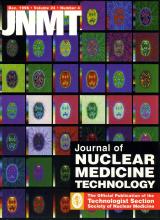Abstract
We present three sequential renal studies in a renal transplant patient, illustrating how technical factors can adversely affect the interpretation of renal imaging studies.
Methods: The studies were performed in two dynamic modes after intravenous injection of 99mTc DTPA. Time-activity curves of the transplanted kidney were later generated. The patient had a Foley catheter during the first study, no catheter in the second study and reinsertion of a catheter in the third study.
Results: The first study revealed good perfusion and function of the transplanted kidney. Three days later, the follow-up renal study revealed stable blood flow, but delayed parenchymal excretion with a photon-deficient area seen adjacent to the transplanted kidney. This was retrospectively interpreted as a full urinary bladder at the time of imaging. A repeat renal study, after insertion of a catheter, showed a normally perfused and functioning renal transplant.
Conclusion: A full urinary bladder on a renal study may simulate the development of acute tubular necrosis, particularly in patients with a transplanted kidney and/or urine outflow obstruction. The bladder should always be empty prior to dynamic renal studies, as a full bladder can cause significant confusion in scan interpretation.







